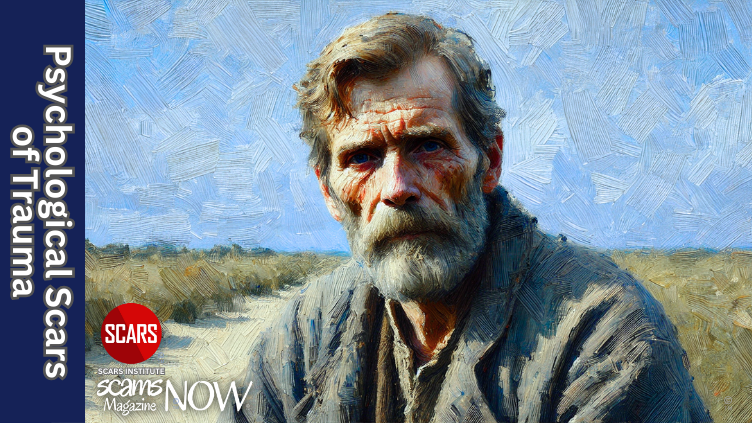The Trickster Hare/Rabbit – Cherokee Fable About Scammers
The Trickster Hare/Rabbit in Cherokee Folklore – a Fable about Scams and Liars
Primary Category: Anthropology of Scams
Author:
• Tim McGuinness, Ph.D., DFin, MCPO, MAnth – Anthropologist, Scientist, Polymath, Director of the Society of Citizens Against Relationship Scams Inc.
About this Article
The Cherokee and Creek story of the Trickster Hare reveals deep truths about deception, trust, and the cost of misplaced belief. In this tale, the Hare boasts of skills he does not possess, offers to help, and uses that offer to trap and betray—only to end up trapped himself. This timeless fable mirrors modern scams, where fraudsters present themselves as helpers offering tech support, legal aid, or investment opportunities, only to exploit their victims for gain. Just like the Hare, today’s scammers use charm and manipulation to disarm skepticism. The story teaches that help offered too quickly, without proof or accountability, often hides a trap. It warns that flashy claims and urgent solutions can be signs of betrayal, not support. The moral of the Trickster Hare’s tale is as relevant now as it was generations ago: real help is verifiable, trust must be earned, and prevention depends on discernment, not desperation. Stories like this are not relics—they are tools of resilience.
Note: This article is intended for informational purposes and does not replace professional medical advice. If you are experiencing distress, please consult a qualified mental health professional.

The Trickster Hare/Rabbit in Cherokee Folklore – a Fable about Scams, Scammers, and Liars
The Anthropology of Scams
In Native American Indian Cherokee and Creek traditions, the Trickster Hare (or Rabbit) is a shape‑shifting (impersonating) character full of contradictions. He can be clever and resourceful, yet he also displays selfishness, mischief, and betrayal.
These Native American stories served as teaching tools about the dangers of life, about morality, and how to live a proper life. They warned listeners about the risks of misplaced trust and overconfidence. Each tale offered guidance on navigating relationships and social expectations. The Trickster Hare often appeared to help others, then turned the help into a betrayal. He mirrored the evolving values and survival strategies of the tribe, particularly during periods of upheaval.
The Trickster Hare/Rabbit Goes Duck Hunting
From Myths of the Cherokee, James Mooney, 1900
The Trickster Hare/Rabbit was so boastful that he would claim to do whatever he saw anyone else do, and so tricky that he could usually make the other animals believe it all.
Once he pretended that he could swim in the water and eat fish just as the Otter did, and when the others told him to prove it, he fixed up a plan so that the Otter himself was deceived.
Soon afterward, they met again, and the Otter said, “I eat ducks sometimes.” Said the Trickster Hare, “Well, I eat ducks too.” The Otter challenged him to try it; so they went up along the river until they saw several ducks in the water and managed to get near without being seen. The Trickster Hare told the Otter to go first. The Otter never hesitated but dived from the bank and swam underwater until he reached the ducks, when he pulled one down without being noticed by the others and came back in the same way.
While the Otter had been under the water the Trickster Hare had peeled some bark from a sapling and made himself a noose. “Now,” he said, “Just watch me;” and he dived in and swam a little way under the water until he was nearly choking and had to come up to the top to breathe. He went under again and came up again a little nearer to the ducks. He took another breath and dived under, and this time he came up among the ducks and threw the noose over the head of one and caught it. The duck struggled hard and finally spread its wings and flew up from the water with the Rabbit hanging on to the noose.
It flew on and on until, at last, the Rabbit could not hold on any longer, but had to let go and drop. As it happened, he fell into a tall, hollow sycamore stump without any hole at the bottom to get out from, and there he stayed until he was so hungry that he had to eat his own fur, as the rabbit does ever since when he is starving. After several days, when he was very weak with hunger, he heard children playing outside around the trees.
He began to sing:
Cut a door and look at me;
I’m the prettiest thing you ever did see.
The children ran home and told their father, who came and began to cut a hole in the tree. As he chopped away, the Trickster Hare inside kept singing, “Cut it larger, so you can see me better; I’m so pretty.” They made the hole larger, and then the Trickster Hare told them to stand back so that they could take a good look as he came out. They stood away back, and the Rabbit watched his chance and jumped out and got away.
Context and Cultural Meaning
This story offers more than entertainment. It reinforces cultural values and caution. Listeners learn that charm and cunning can be used for both benefit and harm. Trickster Hare acts as helper but immediately seeks personal gain. That pursuit leads to his own downfall when pride traps him. The story reminds the community that success built on manipulation is unstable. Wisdom lies in balanced behaviour and understanding long‑term consequences.
In many Native American Indian societies, oral stories were primary teaching tools. Trickster figures helped individuals recognize and resist deception in themselves and others. A helping hand could mask ulterior motives. Actions must align with intentions. Community harmony depended on mutual trust, respect, and accountability.
Parallel to Modern Scams and a Lesson to Learn
Scams today follow the same psychological patterns. A scammer (trickster) pretends to offer support or a solution, fake tech support, fraudulent legal help, bogus charities, fake wealth building through false investments. The generosity and help offered create a welcoming posture. But the ulterior motive is always exploitation. Just like the Trickster Hare, scammers gain trust, then use it to steal data, money, and emotional stability.
The Tale of the Duck Hunting Rabbit teaches key lessons:
Beware of boastful promises: When Rabbit claims he can fish like Otter, the challenge looks like proof of ability. In real life, flashy claims often signal manipulation.
Watch how offers are positioned: The scammer positions himself as a helper, offering solutions. The request for confidence comes before the reveal of the poison.
Trust must be earned: Rabbit’s helper promise was empty. Sustainable trust requires consistency, transparency, and verification.
Initial gain often leads to loss: The Hare catches the duck but then traps himself. Many scam victims experience short‑lived benefit followed by lasting harm.
The Lesson for Prevention: Understanding these repeated motifs can arm victims before they engage. The Hare story encourages questions:
Always ask: Who gains from this help? Is there evidence beyond the offer? What consequences might follow?
Prevention begins with skepticism toward flattering or urgent offers. Real assistance includes checks, accountability, and backup. Isolation and secrecy aid tricksters. Sharing decisions with trusted others often prevents exploitation. The Hare learns humility and caution. Scam awareness requires the same mindset.
Conclusion
The Trickster Hare is more than a myth. It is an early blueprint of how deception operates within human relationships. In this tale, a boastful offer of help masks a selfish motive. The Hare’s confidence wins trust, but his manipulation leads him into a trap of his own making. That arc—from deception to consequence—mirrors the trajectory of modern scams. Today’s fraudsters, like the Hare, present themselves as allies, as experts, as supporters. They offer relief, answers, or opportunity. But underneath those words is a motive shaped by greed and indifference to the damage they cause.
The Cherokee and Creek storytellers understood that scams are not only about money. They are about betrayal of trust. They are about using someone’s hope or fear against them. That is why the story of the Trickster Hare still resonates. It shows that even the most clever manipulator eventually reveals his true intentions. The question is whether others will see through the charm before the trap is sprung.
In scam prevention, the message is simple: examine the offer, verify the identity, and question the motive. Cultural wisdom, passed through stories like this one, can help make those steps instinctive. The Trickster Hare might run free in the end, but the lesson he leaves behind is what protects the next potential victim.
Please Rate This Article
Please Leave Us Your Comment Below
Also, tell us of any topics we might have missed.
-/ 30 /-
What do you think about this?
Please share your thoughts in a comment above!
ARTICLE RATING
TABLE OF CONTENTS
- The Trickster Hare/Rabbit in Cherokee Folklore – a Fable about Scams and Liars
- The Trickster Hare/Rabbit in Cherokee Folklore – a Fable about Scams, Scammers, and Liars
- The Anthropology of Scams
- The Trickster Hare/Rabbit Goes Duck Hunting
- Context and Cultural Meaning
- Parallel to Modern Scams and a Lesson to Learn
- Conclusion
CATEGORIES
U.S. & Canada Suicide Lifeline 988
![NavyLogo@4x-81[1] The Trickster Hare/Rabbit - Cherokee Fable About Scammers - 2025](https://scamsnow.com/wp-content/uploads/2025/04/NavyLogo@4x-811.png)
ARTICLE META
Important Information for New Scam Victims
- Please visit www.ScamVictimsSupport.org – a SCARS Website for New Scam Victims & Sextortion Victims.
- SCARS Institute now offers its free, safe, and private Scam Survivor’s Support Community at www.SCARScommunity.org – this is not on a social media platform, it is our own safe & secure platform created by the SCARS Institute especially for scam victims & survivors.
- SCARS Institute now offers a free recovery learning program at www.SCARSeducation.org.
- Please visit www.ScamPsychology.org – to more fully understand the psychological concepts involved in scams and scam victim recovery.
If you are looking for local trauma counselors, please visit counseling.AgainstScams.org
If you need to speak with someone now, you can dial 988 or find phone numbers for crisis hotlines all around the world here: www.opencounseling.com/suicide-hotlines
Statement About Victim Blaming
Some of our articles discuss various aspects of victims. This is both about better understanding victims (the science of victimology) and their behaviors and psychology. This helps us to educate victims/survivors about why these crimes happened and not to blame themselves, better develop recovery programs, and help victims avoid scams in the future. At times, this may sound like blaming the victim, but it does not blame scam victims; we are simply explaining the hows and whys of the experience victims have.
These articles, about the Psychology of Scams or Victim Psychology – meaning that all humans have psychological or cognitive characteristics in common that can either be exploited or work against us – help us all to understand the unique challenges victims face before, during, and after scams, fraud, or cybercrimes. These sometimes talk about some of the vulnerabilities the scammers exploit. Victims rarely have control of them or are even aware of them, until something like a scam happens, and then they can learn how their mind works and how to overcome these mechanisms.
Articles like these help victims and others understand these processes and how to help prevent them from being exploited again or to help them recover more easily by understanding their post-scam behaviors. Learn more about the Psychology of Scams at www.ScamPsychology.org
SCARS INSTITUTE RESOURCES:
If You Have Been Victimized By A Scam Or Cybercrime
♦ If you are a victim of scams, go to www.ScamVictimsSupport.org for real knowledge and help
♦ SCARS Institute now offers its free, safe, and private Scam Survivor’s Support Community at www.SCARScommunity.org/register – this is not on a social media platform, it is our own safe & secure platform created by the SCARS Institute especially for scam victims & survivors.
♦ Enroll in SCARS Scam Survivor’s School now at www.SCARSeducation.org
♦ To report criminals, visit https://reporting.AgainstScams.org – we will NEVER give your data to money recovery companies like some do!
♦ Follow us and find our podcasts, webinars, and helpful videos on YouTube: https://www.youtube.com/@RomancescamsNowcom
♦ Learn about the Psychology of Scams at www.ScamPsychology.org
♦ Dig deeper into the reality of scams, fraud, and cybercrime at www.ScamsNOW.com and www.RomanceScamsNOW.com
♦ Scam Survivor’s Stories: www.ScamSurvivorStories.org
♦ For Scam Victim Advocates visit www.ScamVictimsAdvocates.org
♦ See more scammer photos on www.ScammerPhotos.com
You can also find the SCARS Institute’s knowledge and information on Facebook, Instagram, X, LinkedIn, and TruthSocial
Psychology Disclaimer:
All articles about psychology and the human brain on this website are for information & education only
The information provided in this and other SCARS articles are intended for educational and self-help purposes only and should not be construed as a substitute for professional therapy or counseling.
Note about Mindfulness: Mindfulness practices have the potential to create psychological distress for some individuals. Please consult a mental health professional or experienced meditation instructor for guidance should you encounter difficulties.
While any self-help techniques outlined herein may be beneficial for scam victims seeking to recover from their experience and move towards recovery, it is important to consult with a qualified mental health professional before initiating any course of action. Each individual’s experience and needs are unique, and what works for one person may not be suitable for another.
Additionally, any approach may not be appropriate for individuals with certain pre-existing mental health conditions or trauma histories. It is advisable to seek guidance from a licensed therapist or counselor who can provide personalized support, guidance, and treatment tailored to your specific needs.
If you are experiencing significant distress or emotional difficulties related to a scam or other traumatic event, please consult your doctor or mental health provider for appropriate care and support.
Also read our SCARS Institute Statement about Professional Care for Scam Victims – click here
If you are in crisis, feeling desperate, or in despair, please call 988 or your local crisis hotline.
More ScamsNOW.com Articles
A Question of Trust
At the SCARS Institute, we invite you to do your own research on the topics we speak about and publish. Our team investigates the subject being discussed, especially when it comes to understanding the scam victims-survivors’ experience. You can do Google searches, but in many cases, you will have to wade through scientific papers and studies. However, remember that biases and perspectives matter and influence the outcome. Regardless, we encourage you to explore these topics as thoroughly as you can for your own awareness.
























![scars-institute[1] The Trickster Hare/Rabbit - Cherokee Fable About Scammers - 2025](https://scamsnow.com/wp-content/uploads/2025/04/scars-institute1.png)
![niprc1.png1_-150×1501-1[1] The Trickster Hare/Rabbit - Cherokee Fable About Scammers - 2025](https://scamsnow.com/wp-content/uploads/2025/04/niprc1.png1_-150x1501-11.webp)
